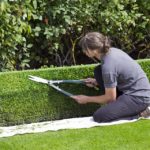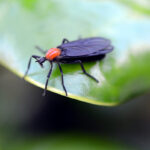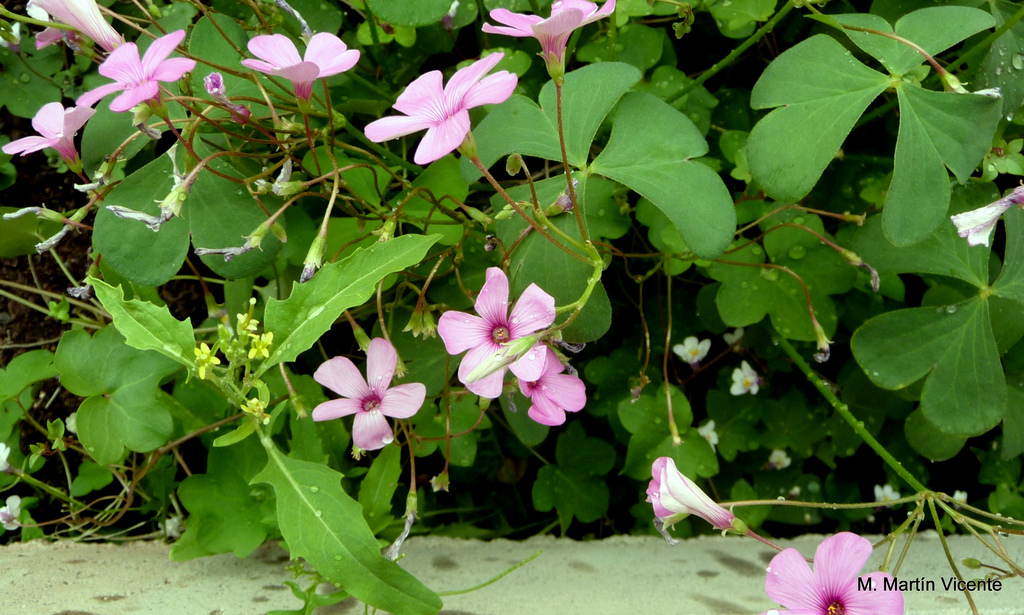
Check out our Richmond lawn care page to see how we are able to make your yard be weed-free.
In the spring, nature bursts forth in Richmond. Cherry trees blossom, azalea bushes flower, peonies open. And weeds gear up to attack. The sooner you get on the situation the better. You let them go too long and it’ll be like trying to get rid of squatters. Know your weeds and strategize how you will protect your lawn.
Photo: Stanze
Hairy Bittercress
Hairy bittercress is easy to recognize because of its club-shaped leaves. Stems rise three to nine inches from the rosette base, and its tiny white flowers evolve into seed pods. When the pods are ripe, they literally explode, hurling seeds out into the environment, so that it spreads very quickly. Hairy bittercress likes cool, moist soil and goes into overdrive after early spring rains.
Because it has a long, deep taproot, you need to dig out the weed with a long, slim weeding tool. Mowing helps. Mow down the flower heads before they become seed pods. Since it tends to die off when the temperature rises, the hair bittercress will die off without ever having reproduced.
Photo: Melissa McMasters
Virginia Buttonweed
Virginia buttonweed spreads horizontally across your lawn with branching hairy stems and elongated leaves joined by a membrane. The leaves are green on the upper surface and light green on the lower. Sometimes they turn a mottled yellow. The star-shaped flowers range from white to purple. Virginia buttonweed is very aggressive in moist, weak, thin areas of your lawn.
The weed reproduces in several ways, which makes it all that more intrusive: by seed, both above and below ground, and from a segment of the plant or root. The strong tap root allows the weed to survive through the winter. The best way to combat Virginia buttonweed is to keep your grass strong and dense.
Photo: Toshiyuki IMAI
Dandelion
Who doesn’t know a dandelion, right? But you may not know that they have been valued for thousands of years: as food high in vitamins and minerals; to make beer and wine; and for its medicinal properties. And don’t forget all those childhood wishes made on the puffball. But none of this is much consolation to a homeowner when dandelions muscle into the lawn and take water and nutrients after from the grass plants.
The stalk of a dandelion is shiny and purplish and grows from 6 to 24 inches high. It terminates in the pappus (aka puffball) that allows the wind to transport the seeds far and wide. The weed gets its name from the margins of the leaves that are deeply serrated: “dent-de-lion” = “tooth of the lion.” The taproot usually penetrates the ground 6 to 18 inches, but it’s been known to grow to 15 feet. Dandelions thrive in moist soil with full sun.
The seeds germinate when the soil temperature is at least 50°F, but when the soil is closer to 77°F, germination greatly accelerates. The best way to gain control is to dig out the entire root. If you can get them in the spring when dandelions are seedlings, all the better.
Photo: Manuel
Oxalis
Sometimes oxalis is not a weed; it’s groundcover. But to most of us, it’s an annoying weed. Oxalis looks somewhat like clover, but its flowers are yellow. Each leaf has three heart-shaped leaflets, and the stems are green to pink. The roots are long, slender rhizomes that form an extensive fibrous system, and it has a taproot.
Oxalis can reproduce from a tiny stem or rhizome fragment that takes root or from tiny pods that eject seeds. You can pull a young weed out by the root. Later, you have to dig out the root. If you cut the foliage close to the ground with shears before it flowers, the weed will die from lack of nutrients.
Photo: Tico
Spotted Spurge
Spotted spurge has leaves that vary from a pale reddish-green to dark green with a purplish spot in the center. The reddish or green prostrate stems grow into a mat that chokes your grass. Spotted spurge loves compacted soil. The small flowers are pinkish-white and germinate in mid-spring. A single plant produces thousands of seeds.
If you get to it soon enough, you can pull spotted spurge out by its root. Be sure to wear gloves. The stem contains a milky substance that is very irritating to the skin and eye. You can also suffocate the weed. Several layers of newspapers or several inches of wood mulch will prevent seeds from germinating and kill existing plants.
Need help tending to your lawn? Visit our Richmond lawn care page for more info! In addition to Richmond, we also provide lawn care service in Glen Allen, Midlothian, Mechanicsville, and Henrico.





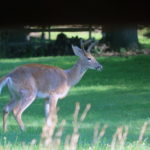
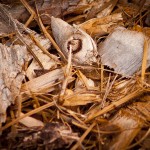
![8 Best Garden Scissors of 2024 [Reviews]](https://www.lawnstarter.com/blog/wp-content/plugins/related-posts/static/thumbs/8.jpg)

